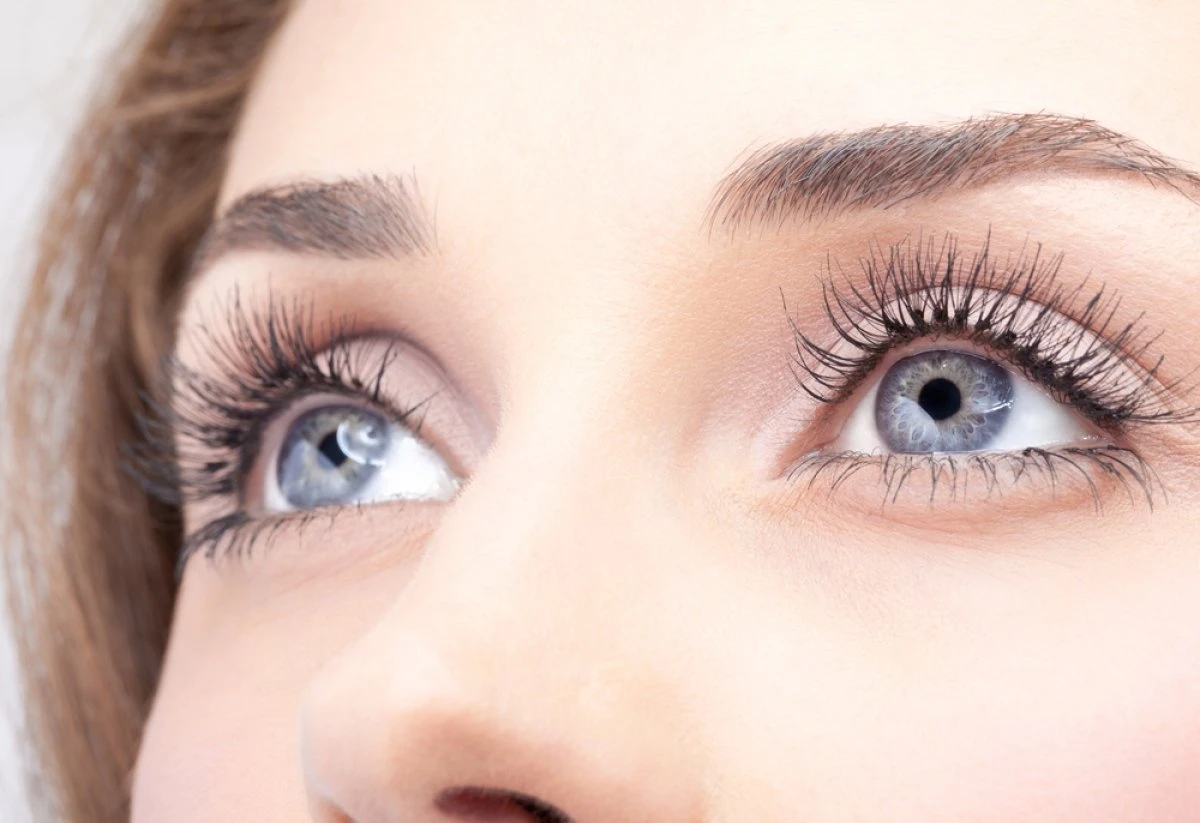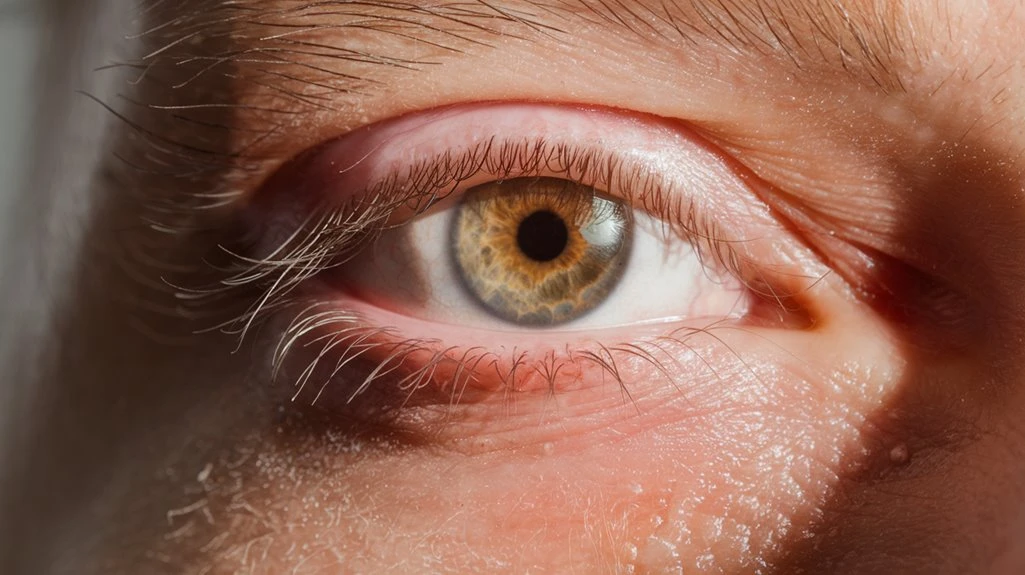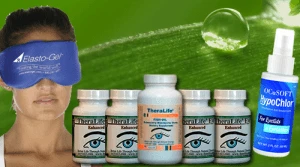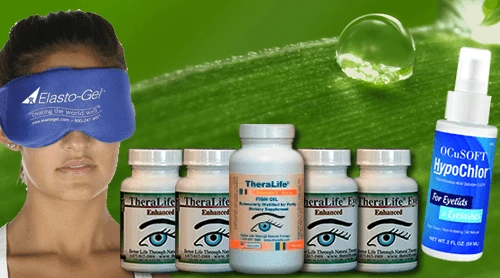Theralife.com offers products specifically designed to address the symptoms of Meibomian Gland Dysfunction (MGD) blepharitis. Customers often experience relief from symptoms such as red, irritated eyelid margins, grittiness, and fluctuating vision. Theralife products help stabilize the tear film, reducing excessive tearing and dry eye symptoms. They also mitigate mild eyelid swelling and light sensitivity. For those experiencing crusting and flaking, Theralife provides effective solutions, especially when other forms of blepharitis are present. These products are invaluable for recognizing and managing symptoms, enhancing comfort and eye health.
Best MGD/Blepharitis Treatment From TheraLife- When Drops Don’t Work.
Key Takeaways
- Grittiness or a foreign body sensation in the eyes, often described as having sand or irritation.
- Excessive tearing or burning, stinging, and intermittent blurred vision, reflecting disrupted tear film and dry eye symptoms.
- Redness and mild irritation along the eyelid margin, sometimes with visible plugging of gland openings.
- Fluctuating or blurred vision, especially during prolonged visual tasks, that improves temporarily with blinking.
- Symptoms often improve with diligent eyelid hygiene practices, such as warm compresses and gentle lid cleansing.
Redness and Irritation Along the Eyelid Margin
Although redness and irritation along the eyelid margin are commonly associated with various ocular surface disorders, they’re not defining symptoms of Meibomian Gland Dysfunction (MGD). When you evaluate for MGD, it’s important to recognize that these findings may result from overlapping conditions such as anterior blepharitis, allergic conjunctivitis, or general eyelid inflammation, rather than MGD itself.
Clinically, you’ll focus on the functional assessment of the meibomian glands, meibum quality and expressibility, and changes in the tear film. While eyelid margin erythema may appear, it doesn’t specifically indicate gland dysfunction. Eyelid hygiene remains a foundational component of management, regardless of symptom presence.
Treatment options—such as warm compresses, lid scrubs, and topical agents—should be tailored based on gland assessment, not just the presence of redness or irritation. Regular eye checks are recommended: every two years for young individuals without a history of MGD, and annual or bi-annual checks for those with a family history or frequent symptoms.
Grittiness or Foreign Body Sensation
Grittiness, often described by patients as a sensation of having sand or a foreign particle in the eye, represents a nonspecific symptom seen across various ocular surface diseases.
In Meibomian Gland Dysfunction (MGD) blepharitis, this sensation is primarily due to an altered lipid layer, resulting in suboptimal eye lubrication. Your compromised tear film exposes the corneal and conjunctival surfaces to increased friction and microtrauma.
Effective management requires you to address the underlying pathophysiology. Consider these facts:
- Grittiness arises from disrupted meibomian gland secretions impacting the tear film’s stability.
- Poor eye lubrication leads to increased epithelial cell desquamation and discomfort.
- Meticulous eyelid hygiene can decrease debris and inflammatory mediators on the lid margin.
- Inflammation perpetuates a cycle of gland obstruction, increasing the sensation’s persistence.
- Meibomian glands are crucial for maintaining the tear film by secreting meibum, which forms a protective layer against evaporation.
Excessive Tearing or Dry Eye Symptoms
Many patients with Meibomian Gland Dysfunction (MGD) paradoxically report both excessive tearing (epiphora) and symptoms of ocular dryness.
If you have MGD, the altered meibum secretion disrupts the lipid layer of the tear film, leading to increased tear evaporation and ocular surface instability. Despite watery eyes, your symptoms reflect underlying tear film insufficiency, causing ocular irritation and reflex tearing.
This instability manifests as burning, stinging, and intermittent blurred vision, which may mimic classic dry eye symptoms. Clinicians often recommend dry eye treatments that address the disrupted tear film—including lid hygiene, warm compresses, and lipid-based tear substitutes—to improve comfort and reduce reflex tearing.
Correctly identifying and managing the underlying MGD is essential for effective symptom relief and peak ocular surface health. Additionally, inflammatory cytokines play a significant role in the development of dry eye symptoms, further complicating the condition and necessitating comprehensive treatment approaches.
Crusting and Flaking of the Eyelids
Crusting and flaking of the eyelids aren’t hallmark features of Meibomian Gland Dysfunction (MGD).
You’ll typically see these findings associated more with anterior blepharitis, which involves inflammation of the eyelid margin near the eyelashes.
MGD, by contrast, primarily disrupts the lipid layer of the tear film, causing symptoms such as dry eye and irritation.
However, if you do experience crusting or flaking, evaluate for alternative or concurrent etiologies.
Effective eyelid hygiene remains integral for both conditions.
If you notice these symptoms, consider the following steps:
- Evaluate for anterior blepharitis or other causes.
- Practice diligent eyelid hygiene such as warm compresses and gentle lid scrubs.
- Consult your eye care specialist for precise diagnosis.
- Discuss targeted treatment options for ideal management.
Additionally, Theralife products are recommended by healthcare professionals for effective management of blepharitis symptoms, including improvements in meibomian gland function.
Blurred or Fluctuating Vision
While crusting and flaking may point toward anterior blepharitis, visual symptoms like blurred or fluctuating vision more commonly relate to Meibomian Gland Dysfunction (MGD).
When your meibomian glands fail to secrete adequate or high-quality lipids, the tear film becomes unstable, accelerating evaporation. This instability leads to vision changes, such as intermittent blurring or shifts in sharpness, particularly during tasks requiring sustained visual attention—like reading or screen use.
You’ve likely noticed these fluctuations correlate with increased eye strain, as the optical surface is no longer smooth, requiring extra accommodative effort. Evidence shows that blinking can temporarily restore clarity by redistributing the tear film, but the underlying dysfunction persists. Artificial Tears can provide temporary relief for dry eyes, though they may worsen dryness over time if overused.
Recognizing fluctuating vision as a hallmark of MGD is essential for accurate diagnosis and effective management.
Eyelid Swelling and Tenderness
Although eyelid swelling and tenderness are frequently associated with inflammatory eyelid conditions, they’re not primary symptoms of Meibomian Gland Dysfunction (MGD).
MGD typically presents with symptoms more closely linked to altered tear film and gland obstruction rather than overt inflammation. However, you might occasionally notice minimal swelling or discomfort, often secondary to gland obstruction or coexisting blepharitis.
For accurate diagnosis and effective eyelid care, it’s essential to distinguish these signs from more classic manifestations. Common causes of MGD-related blepharitis include bacterial infection and meibomian gland dysfunction, which can exacerbate symptoms.
Here are four clinical considerations:
- Swelling and tenderness may indicate concurrent infectious or inflammatory eyelid disease.
- Primary MGD signs usually involve gland dropout, altered secretions, and tear film instability.
- Non-specific eyelid tenderness can complicate diagnosis and management.
- Treatment options focus on improving meibum quality, not primarily reducing swelling.
Sensitivity to Light
Despite its association with various ocular surface disorders, sensitivity to light—also known as photophobia—is not regarded as a primary symptom of Meibomian Gland Dysfunction (MGD).
You might experience light sensitivity triggers if you have concurrent ocular conditions such as dry eye disease, but MGD by itself typically doesn’t result in marked photophobia.
Clinically, MGD primarily disrupts the tear film’s lipid layer, leading to symptoms like dryness, irritation, and blurry vision rather than direct light sensitivity.
If you’re experiencing significant photophobia, it’s vital to evaluate other potential etiologies such as conjunctival or corneal inflammation.
Meibomian gland dysfunction is linked to dry eye syndrome and chalazion formation, highlighting the importance of proper eyelid hygiene and management strategies.
Coping strategies for secondary light sensitivity include wearing sunglasses, optimizing ambient lighting, and managing any overlapping ocular pathology.
Always consult your eye care provider for targeted assessment and tailored treatment.
Best MGD/Blepharitis Treatment From TheraLife- When Drops Don’t Work.
Frequently Asked Questions
What Causes Meibomian Gland Dysfunction Blepharitis?
When considering causes overview for meibomian gland dysfunction blepharitis, you’ll find that altered gland function is central.
Factors such as gland obstruction, hyperkeratinization, and bacterial colonization disrupt lipid secretion, compromising the tear film. Hormonal changes, rosacea, and chronic inflammation can also impair the meibomian gland function.
Evidence suggests environmental stressors, contact lens wear, and certain medications further exacerbate dysfunction.
Managing these causes is essential for restoring glandular homeostasis and improving ocular surface health.
How Is Meibomian Gland Dysfunction Diagnosed?
Imagine your eyelids are like a town’s oil mills—when they don’t function, the town suffers.
To diagnose meibomian gland dysfunction, your doctor first conducts a thorough symptom assessment, just as a city inspector checks for issues.
Then, they use diagnostic tests such as gland expression evaluation, meibography to visualize glands, and tear film analysis.
These methods let you and your clinician precisely identify dysfunction and determine the best evidence-based treatment options.
Is Meibomian Gland Dysfunction Contagious?
You don’t need to worry about Meibomian Gland Dysfunction (MGD) being contagious.
MGD results from blocked or malfunctioning oil glands in your eyelids, not from an infectious process. Evidence shows it can’t spread between individuals.
Maintaining ideal eye health involves daily eyelid hygiene to manage symptoms and prevent complications, but you won’t transmit MGD to others through contact or shared personal items.
The primary concern is gland dysfunction, not contagion.
Can Lifestyle Changes Help Manage Symptoms?
Lifestyle changes can greatly help you manage symptoms of Meibomian Gland Dysfunction. Evidence indicates that dietary adjustments, such as increasing omega-3 fatty acids, enhance meibum quality and tear film stability.
Stress management practices, including mindfulness and adequate sleep, reduce inflammatory markers implicated in gland dysfunction. Additionally, adhering to eyelid hygiene protocols and limiting exposure to digital screens support ocular surface health, creating an all-encompassing, multifactorial approach to symptom mitigation and long-term ocular surface improvement.
What Are the Treatment Options for This Condition?
Think of your eyelids as a car engine needing regular oil changes.
You’ve got several treatment options—start with home remedies like warm compresses and lid scrubs to melt and clear blocked meibum.
Therapeutic eye drops, including artificial tears or prescription anti-inflammatory drops, can reduce irritation and restore tear stability.
In persistent cases, your ophthalmologist may recommend oral antibiotics or in-office procedures like thermal pulsation therapy for ideal gland function.
Best MGD/Blepharitis Treatment From TheraLife- When Drops Don’t Work.
Conclusion
Recognizing meibomian gland dysfunction blepharitis involves identifying symptoms such as lid margin erythema, foreign body sensation, and fluctuating vision. TheraLife’s products offer significant benefits in addressing these symptoms, promoting ocular comfort and reducing inflammation. Their range of natural supplements and treatments is designed to restore balance to your visual environment, preventing chronic discomfort and supporting ocular homeostasis. By incorporating TheraLife’s solutions into your routine, you can effectively manage and alleviate the symptoms of blepharitis, enhancing your overall eye health and well-being.





